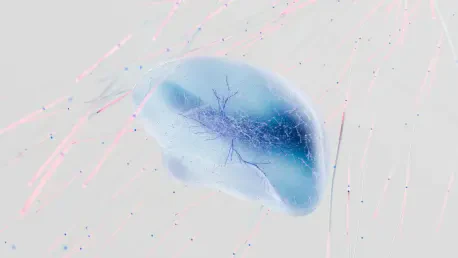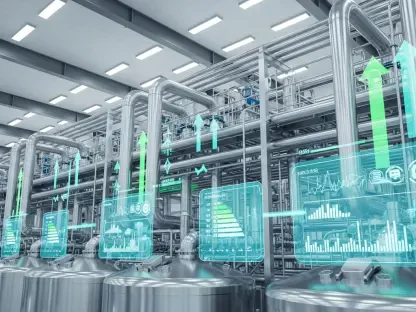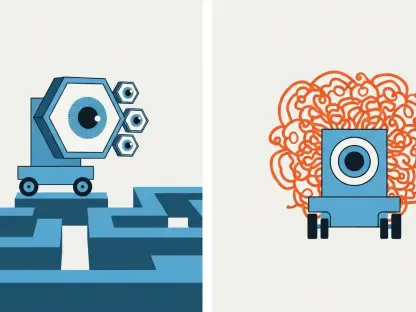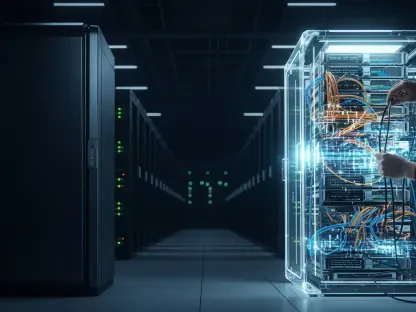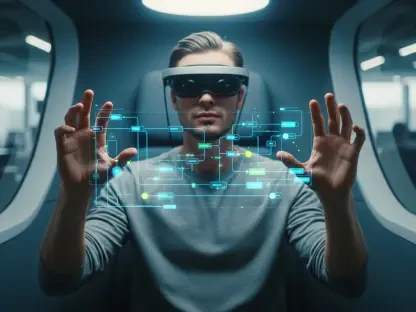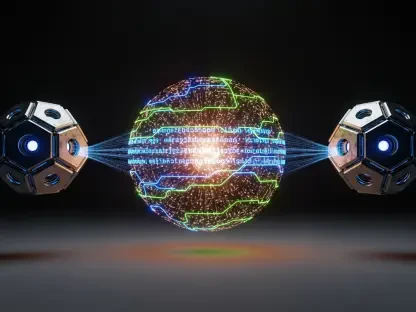In an era where artificial intelligence seems to dominate every facet of technological advancement, a profound and thought-provoking question arises: could the humble brain cell, a fundamental unit of human cognition, possess learning capabilities that surpass even the most sophisticated machine learning algorithms developed today? Recent research spearheaded by Cortical Labs in Melbourne, in collaboration with renowned global institutions, has unearthed startling revelations that challenge the presumed superiority of synthetic systems over biological ones. This exploration into the learning prowess of brain cells versus deep reinforcement learning models not only captivates the imagination but also hints at a future where nature’s designs might inform the next wave of computing innovations. By integrating human stem cell-derived neurons with silicon hardware in a system dubbed “DishBrain,” scientists have opened a window into how biological systems adapt and learn in real-time scenarios. The implications of this work stretch far beyond academic curiosity, potentially reshaping how intelligence itself is understood and applied. As this article unfolds, the remarkable efficiency of biological learning, the groundbreaking tools driving this research, and the broader questions about the essence of intelligence will come into sharp focus, inviting a deeper consideration of what it means to learn.
Biological Learning vs. Machine Learning
Unveiling Superior Efficiency
A cornerstone of the recent study by Cortical Labs lies in the innovative DishBrain system, a hybrid platform where lab-cultivated human neurons are interfaced with silicon hardware to simulate learning environments. This setup allowed researchers to observe brain cells engaging in tasks like playing a simplified version of the classic game Pong, providing a unique opportunity to measure their learning capabilities against artificial intelligence models. What emerged from these experiments was a striking revelation: biological neural cultures demonstrated an exceptional ability to master tasks with far fewer training examples than their synthetic counterparts. Known as “sample efficiency,” this trait underscores a significant gap between biological systems and deep reinforcement learning algorithms such as DQN or PPO, which often require millions of iterations to achieve similar proficiency. This efficiency suggests that nature has honed mechanisms over millennia that artificial systems struggle to replicate, even with vast computational resources at their disposal. The findings point to a potential paradigm shift, where insights from biological learning could inspire more streamlined and less data-hungry AI models, addressing one of the critical bottlenecks in current technology development.
Further exploration into the DishBrain experiments reveals that the superior sample efficiency of biological neurons isn’t merely a statistical anomaly but a reflection of inherent design advantages. Unlike machine learning algorithms that rely on extensive trial-and-error processes across countless data points, the neural cultures adapted swiftly within constrained real-world timeframes. This rapid learning curve was evident as the cells adjusted their responses during gameplay, achieving measurable progress with minimal exposure to stimuli. Such adaptability hints at underlying principles of biological systems that prioritize efficiency over brute computational power, a stark contrast to the resource-intensive nature of most AI training regimens. Researchers noted that while artificial systems excel in controlled, data-rich environments, they falter when faced with the unpredictable, limited-data scenarios that biological systems navigate effortlessly. This disparity raises intriguing questions about whether AI development should pivot toward mimicking these natural efficiencies, potentially leading to technologies that learn more intuitively and sustainably in dynamic, real-world contexts.
The Power of Neural Plasticity
Another dimension of biological learning that sets it apart from machine learning is the remarkable plasticity of neural networks, their ability to reorganize and adapt based on incoming feedback. Within the DishBrain system, scientists observed how neural activity dynamically evolved during real-time tasks, with connections between cells strengthening or weakening in response to gameplay outcomes. This plasticity mirrors the fundamental way human brains adjust to new experiences, continuously reshaping neural pathways to optimize learning and behavior. Such adaptability offers a glimpse into why biological systems can respond so effectively to novel situations without requiring extensive retraining, a feat that remains elusive for most artificial intelligence models. The implications of this finding are profound, suggesting that future AI could benefit immensely from architectures inspired by this natural flexibility, enabling systems to evolve in real time rather than remaining static post-training.
Delving deeper into the plasticity observed in these experiments, it becomes clear that this dynamic reorganization is not a random process but a structured response to environmental cues. The neural cultures in DishBrain exhibited distinct patterns of electrical activity during active gameplay compared to rest periods, providing quantitative evidence of how learning manifests at a cellular level. This ability to map and analyze spiking neural activity in lower-dimensional spaces allowed researchers to correlate specific behavioral outcomes with underlying neural changes, offering insights into the mechanisms of intelligence itself. Unlike rigid algorithmic structures in machine learning, where updates often necessitate comprehensive retraining, the biological systems demonstrated an organic capacity for incremental improvement. This inherent adaptability could pave the way for AI systems that learn continuously and contextually, much like living organisms, potentially transforming applications in fields requiring real-time decision-making, such as autonomous navigation or personalized medicine.
Innovations in Biological Computing
The CL1 Platform Breakthrough
Taking the theoretical insights from biological learning to a practical level, Cortical Labs has introduced the CL1, heralded as the world’s first commercial biological computer. This pioneering platform integrates live neural cultures with high-density multi-electrode arrays, creating a hybrid system that leverages the unique properties of biological intelligence for computational tasks. The CL1 represents a significant leap forward, bridging the gap between experimental neuroscience and tangible technology by offering a sustainable alternative to traditional silicon-based computing. Its design allows for the study and application of neural activity in controlled settings, opening doors to potential uses ranging from drug testing to simulating neurological conditions. By embodying the principles of biological learning efficiency, the CL1 stands as a testament to the feasibility of merging organic and synthetic systems, challenging the industry to rethink the foundations of computing infrastructure in favor of more adaptive and energy-efficient solutions.
Beyond its immediate applications, the CL1 serves as a testing ground for broader innovations in how intelligence can be harnessed commercially. The platform’s ability to sustain live neural cultures while interfacing with advanced hardware provides a scalable model for exploring complex computational challenges. Researchers envision the CL1 contributing to fields as diverse as gaming simulations, where biological systems could offer more nuanced and responsive AI opponents, or in healthcare, where it might simulate brain responses to new therapies. This versatility underscores the transformative potential of biological computing, positioning it as a viable complement to, or even competitor with, existing AI technologies that grapple with high energy consumption and scalability issues. The development of the CL1 marks a pivotal moment, illustrating that the integration of biological intelligence into everyday technology is not a distant dream but a burgeoning reality with far-reaching implications for multiple sectors.
Expanding Horizons with Hybrid Technology
The advent of the CL1 platform also sparks a broader conversation about the future trajectory of hybrid technologies that blend biological and artificial components. This innovative system is not merely a tool for research but a blueprint for creating computing environments where the strengths of neural adaptability enhance algorithmic precision. By embedding human-derived neurons into silicon frameworks, the CL1 demonstrates how biological systems can process information in ways that traditional AI struggles to match, particularly in terms of learning speed under constrained conditions. Such hybrid models could address critical limitations in current machine learning approaches, offering solutions that are less dependent on massive datasets and more aligned with the intuitive learning seen in nature. This convergence of disciplines hints at a future where technology draws directly from biological principles to create systems that are not only powerful but also inherently sustainable and responsive to real-world complexities.
Moreover, the implications of hybrid technology extend into uncharted territory, prompting speculation about how far this integration can be pushed. The CL1’s success in maintaining neural cultures for extended periods while interfacing with digital systems suggests potential for even more sophisticated platforms in the coming years. Imagine computing systems that not only process data but also evolve their processing methods based on experiential learning, much like a living brain. Such advancements could revolutionize industries reliant on adaptive intelligence, from robotics to personalized education tools, by providing systems capable of tailoring responses to individual needs without exhaustive reprogramming. The CL1, as a pioneering step, sets a precedent for exploring these possibilities, encouraging investment and research into biological computing as a legitimate and promising frontier that could redefine technological progress in profound ways.
Redefining Intelligence
Biological Roots of Intelligence
At the heart of this groundbreaking research lies a fundamental debate about the very nature of intelligence: is it an inherently biological phenomenon, or can synthetic systems ultimately replicate and surpass it? Proponents of biological intelligence, including key researchers at Cortical Labs, argue that the unique learning efficiencies and adaptive capacities of neural systems point to a deeper, intrinsic quality of intelligence rooted in living organisms. This perspective challenges the AI community to reconsider benchmarks of success, suggesting that true mastery of learning may lie in understanding and emulating the brain’s organic processes rather than solely refining computational algorithms. The notion that intelligence might be fundamentally biological carries significant weight, pushing for a reevaluation of how AI is designed and prompting a shift toward systems that prioritize natural learning mechanisms over sheer processing power, potentially altering the trajectory of technological evolution.
This debate also illuminates the limitations of current artificial intelligence, which, despite remarkable achievements in specific tasks, often lacks the nuanced adaptability seen in even the simplest biological systems. The DishBrain experiments underscore how neural cultures can achieve complex behaviors with minimal input, a stark contrast to the data-intensive nature of deep learning models. Such findings fuel arguments that intelligence, at its core, may be tied to the dynamic, experiential learning inherent in biology, rather than the static, rule-based frameworks of synthetic systems. This perspective does not dismiss the value of AI but rather suggests a complementary role where biological insights could enhance artificial systems, leading to a more holistic understanding of intelligence. As this discussion evolves, it becomes evident that exploring biological roots could unlock new methodologies for creating AI that mirrors the resilience and creativity of human cognition.
Pathways to Hybrid Systems
Looking ahead, the research introduces two innovative pathways—Bioengineered Intelligence (BI) and Organoid Intelligence (OI)—as strategies to harness biological systems for computational advancements. BI focuses on designing specific neural circuits tailored for targeted computing tasks, aiming to optimize information processing through engineered biological structures. This approach seeks to create purpose-built systems that leverage the efficiency of neural learning for specific applications, such as pattern recognition or decision-making under uncertainty. Meanwhile, OI explores the use of three-dimensional brain-like structures, known as organoids, for broader scientific and biomedical applications, potentially contributing to insights into consciousness or therapeutic developments. Both pathways represent a bold vision for integrating biological intelligence into technology, each offering distinct advantages that could reshape how computational challenges are addressed in diverse fields.
The complementary nature of BI and OI also highlights a strategic duality in approaching biological computing, balancing immediate, application-driven solutions with long-term scientific inquiry. BI’s emphasis on engineered circuits promises quicker integration into existing technological frameworks, providing tangible benefits for industries needing adaptive, efficient systems. On the other hand, OI’s focus on replicating brain-like structures opens avenues for fundamental research, potentially unraveling mysteries of neural function that could inform future innovations. Together, these pathways suggest a future where biological and synthetic intelligence coexist, each enhancing the other to tackle problems neither could solve alone. This hybrid vision encourages a multidisciplinary approach, fostering collaborations that could lead to breakthroughs in computing power, energy efficiency, and even ethical considerations surrounding the manipulation of biological materials for technological gain.
Challenges and Future Directions
Ethical and Practical Considerations
As the integration of biological systems into computing gains momentum, it brings with it a host of ethical dilemmas that demand careful scrutiny. Manipulating human-derived neurons for technological purposes raises profound questions about the boundaries of science and the moral implications of such interventions. Issues of consent, the potential for exploitation, and the long-term consequences of creating hybrid biological-synthetic systems must be addressed to ensure responsible progress. Researchers in this field emphasize the importance of establishing robust guidelines that balance innovation with societal values, recognizing that unchecked advancement could lead to unintended consequences. The infancy of biological computing necessitates a cautious approach, where ethical frameworks evolve alongside technological capabilities to safeguard against misuse while fostering an environment conducive to groundbreaking discoveries.
Beyond ethics, practical challenges also loom large in scaling biological computing for widespread application. Maintaining live neural cultures in a stable, functional state over extended periods poses significant technical hurdles, requiring advancements in bioengineering to ensure reliability and reproducibility. Additionally, integrating these systems with existing digital infrastructures demands innovative solutions to compatibility issues, as well as substantial investment in research and development. The high cost and complexity of such endeavors could limit accessibility, potentially widening the gap between cutting-edge technology and broader societal benefit. Addressing these practical barriers is crucial for translating the promise of biological intelligence into real-world impact, ensuring that the benefits of this research are not confined to theoretical realms but can be harnessed for tangible, inclusive advancements in technology.
Collaborative Frontiers
The interdisciplinary nature of this research, spanning neuroscience, bioengineering, and artificial intelligence, underscores a growing consensus that biological systems may offer solutions to some of AI’s most pressing limitations, such as excessive energy consumption and dependency on vast datasets. Collaborations across global institutions have fueled progress in this field, bringing together diverse expertise to tackle complex challenges from multiple angles. This collective effort highlights the potential for biological intelligence to inspire more sustainable and adaptive computing models, addressing inefficiencies that plague current AI technologies. The shared recognition of these possibilities is driving investment in hybrid systems, with the aim of creating technologies that learn and evolve in ways akin to natural organisms, potentially revolutionizing industries reliant on real-time adaptability.
Reflecting on the strides made through these collaborative efforts, it’s evident that the journey of integrating biological and artificial intelligence has only just begun. The past few years have seen the inception of platforms like the CL1 and the conceptualization of pathways such as BI and OI, setting a foundation for future exploration. Moving forward, the focus should shift toward fostering international partnerships to accelerate research, alongside developing educational initiatives to prepare the next generation of scientists and engineers for this hybrid frontier. Encouraging open dialogue about ethical implications will also be vital, ensuring that advancements remain aligned with societal needs. As this field has matured in recent times, it has laid critical groundwork; now, the challenge lies in building upon those achievements to create a future where the line between biological and synthetic intelligence blurs, promising transformative solutions to some of technology’s most enduring problems.
